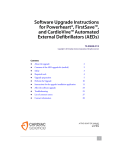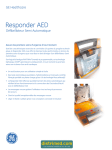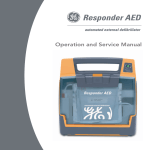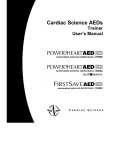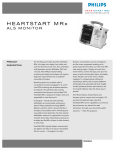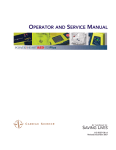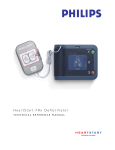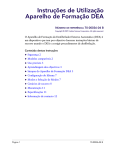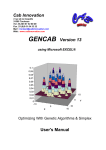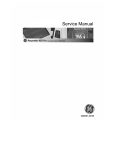Download Pediatric Reduced Energy Defibrillation
Transcript
Pediatric Reduced Energy Defibrillation Electrodes Instructions for Use 112-2013-003 A Copyright © 2008 Cardiac Science Corporation. All rights reserved. For use with the following Cardiac Science Automated External Defibrillators (AEDs) only: Powerheart AED 9200 series, Powerheart AED G3 9300 series, and FirstSave AED 9300 series. ! Caution: Restricted sale. Federal law restricts this device to sale by or on the order of a physician or other licensed practitioner. Indications for Use Indications for Use Cardiac Science Pediatric Reduced Energy Defibrillation Electrodes are intended for use with only the following Cardiac Science Automated External Defibrillators (AEDs): Powerheart AED 9200 series, Powerheart AED G3 9300 series, and FirstSave AED 9300 series. These electrodes, when used with the AED, provide reduced defibrillation energy and are intended for use only on children or infants up to 8 years old, or up to 55 lbs (25 kg). If the child appears older or larger, use Cardiac Science adult defibrillation electrodes. Do not delay treatment to determine the child's exact age or weight. The AED is intended for use by personnel who have been trained in its operation. The user should be qualified by training in basic life support or other physician-authorized emergency medical response. The AED is indicated for emergency treatment of victims exhibiting symptoms of sudden cardiac arrest who are unresponsive and not breathing. Postresuscitation, if the victim is breathing, the AED should be left attached to allow for acquisition and detection of the ECG rhythm. If a shockable ventricular tachyarrhythmia recurs, the AED will charge automatically and advise the operator to deliver therapy. Contraindications for Use Do not use with Cardiac Science 9100 series AEDs, FirstSave 9200 AEDs, or non-Cardiac Science AEDs. 112-2013-003 A 1 Pediatric Reduced Energy Defibrillation Electrodes Instructions for Use Warnings and Cautions ! ! ! ! ! ! 2 WARNING! Improper function. For use only with the following Cardiac Science AEDs: Powerheart AED 9200 series, Powerheart AED G3 9300 series, and FirstSave AED 9300 series. These pads will not function properly with any other AEDs or defibrillators. WARNING! Shock hazard. During shock delivery, an AED applies high voltage to the patient. Do not touch the patient, pads or any other equipment connected to the patient when defibrillating. WARNING! Improper connection. DO NOT pre-connect Pediatric electrodes to an AED while in standby mode. Caution: Electrode degradation. DO NOT open the package until ready to use the pads. Caution: Equipment damage. Remove the Cardiac Science pediatric electrode pads before using other manufacturers' defibrillation equipment. Caution: Improper equipment performance. Using pads that are damaged or expired may result in improper AED performance. Examine the pads before use; the package should be sealed and the expiration date should not have passed. Do not use pads if expired. 112-2013-003 A Operating/Storage Conditions The Cardiac Science Pediatric Electrode System is FDA-cleared for use with the Powerheart AED 9200 series, Powerheart AED G3 9300 series, and FirstSave AED 9300 series. to treat children less than 8 years of age or less than 55 lbs who suffer cardiac arrest. FDA 510(k) marketing clearance was received with the adult energy protocol set to the 200J Variable Energy (“VE”) protocol, and by demonstrating the ability of Cardiac Science's Pediatric Electrode System to automatically and safely reduce or “attenuate” the energy level of defibrillation shock(s) for children to approximately 50J. Your AED medical director may choose this energy protocol or any of the other energy protocols which can be programmed in the Powerheart AED by using the MDLink software and connecting your PC via the enclosed serial cable to the Powerheart AED 9200 series and Powerheart AED G3 9300 series. FirstSave AED G3 is preset to 200J variable energy. Please call customer service at 888-466-8686 if you need assistance. The Cardiac Science Pediatric Defibrillation Electrodes are: Disposable Single patient use only Do not reuse Latex Free These symbols can be found on the packaging or on the electrodes: Attention required. Consult the accompanying documents or AED Operation and Service Manual for additional information Consult instructions for Use Operating/Storage Conditions Store electrodes in a cool, dry place 0°C to 43°C or 32°F to 110°F) Humidity: 5% to 95% (non-condensing) Shipping Temperature Range: -30°C to 65°C (-22°F to 149°F) 112-2013-003 A 3 Pediatric Reduced Energy Defibrillation Electrodes Instructions for Use Instructions for Use ! WARNING! AED not rescue ready. If the rescuer performs the steps below in a different sequence than outlined, the AED may give a “check electrodes” or “check pads” message. Unlike Cardiac Science adult defibrillation electrodes, the construction of our pediatric electrodes does not allow a Cardiac Science AED to check that there is an adequate connection and that the electrodes are ready to use prior to their being applied to the patient. 1. Remove clothing from the patient's chest and make sure the patient's chest is clean and dry. 2. Tear open the pediatric pads package and remove the pads. 3. Carefully peel one pad away from the liner. 4. Standard pads placement (Figure 1) a. Place one pad with the sticky side to the patient's bare skin, on the upper right chest as shown in Figure 1. Press the pad firmly to the patient's skin. b. Carefully peel the second pad away from the liner. c. Place the second pad on the Figure 1: Standard pads placement (recommended) patient's lower left chest as shown in Figure 1. 5. Open the AED lid. If adult electrode pads are attached to the AED, disconnect them before connecting the pediatric pads. 4 112-2013-003 A Instructions for Use 6. Connect the pediatric pads to the AED. To attach, match the connector colors (red to red) from the pads to the AED and slide together until the connectors are firmly attached. 7. The AED begins patient analysis. Refer to the AED Operator’s and Service Manual for additional operating information. Note: Pads can be placed in either position on the patient (e.g., either pad can be placed on the chest or back position as shown in Figure 1, standard pads placement). 8. Alternative pads placement (Figure 2) a. Place one pad with the sticky side to the patient's bare skin, in the center of the chest, as shown in Figure 2. Press the pad firmly to the patient's skin. b. Carefully peel the second pad away from the liner. Figure 2: Alternative pads placement c. Place the second pad on the patient's back, as shown in Figure 2. Note: Pediatric electrode pads are for short-term use only. One set of Cardiac Science Pediatric Electrode Pads can be used to monitor a patient for 2 hours and deliver up to 15 shocks. To remove electrode pads, slowly peel back the edge of the pads away from the patient’s skin. Dispose of the used pads. 112-2013-003 A 5 Pediatric Reduced Energy Defibrillation Electrodes Instructions for Use Attenuated Energy Values With Cardiac Science Pediatric Electrode Pads and STAR Biphasic Waveform Typical waveform: 50J 50-ohm patient impedance 50J – All values are typical Phase 1 Patient’s Impedance (ohms) 25 50 75 100 125 6 Voltage (volts) 442 632 738 806 852 Phase 2 Duration (ms) 6.1 7.3 8.6 9.9 11.1 Voltage (volts) 301 427 489 520 535 Duration (ms) 3.2 3.2 3.2 3.2 3.2 Energy (Joules) 40 50 51 50 46 112-2013-003 A Changing the Shock Protocol Changing the Shock Protocol To change the shock protocol, you must have the MDLink software installed on your PC. (MDLink is shipped with your AED on the Quick Start CD-ROM.) Note: MDLink is not for use with the FirstSave G3 AED. After installing the MDLink software on the PC and connecting the AED (use the serial communication cable that was shipped with your AED): 1. Click Get AED Configuration. 2. Set the Shock Energy Protocol to the last selection (200VE, 200VE, 200VE). 3. Click Set AED Configuration. 4. Click Exit. This completes the programming of your AED and sets it to the proper protocol when potentially using pediatric electrodes. If you have any questions or problems, please contact Cardiac Science’s 24-hour customer care at 1 (800) 425-402-2000 or [email protected]. 112-2013-003 A 7 Pediatric Reduced Energy Defibrillation Electrodes Instructions for Use 2 3 1 4 8 112-2013-003 A Summary of RHYTHMx Clinical Results: Summary of RHYTHMx Clinical Results: The Powerheart AED employs the patented RHYTHMx analysis algorithm designed and developed by Cardiac Science. The RHYTHMx algorithm was first marketed in the Powerheart AECD for in-hospital use and later adapted for use in the Powerheart AED. No modifications have been made to the RHYTHMx algorithm for pediatric applications. The RHYTHMx analysis algorithm has a proven history of successful clinical use on thousands of adult patients over the past several years. In addition, Cardiac Science has completed extensive database testing with the RHYTHMx algorithm that demonstrates an extremely high rate of sensitivity and specificity. SVT Detection Feature A feature that makes the RHYTHMx algorithm uniquely suited for pediatric applications is its SVT detection and discrimination function. It uses two distinct rates for determining when a rhythm is shockable. For chaotic heart rhythms, such as VF, the default rate for deciding when the rhythm is shockable is 160 beats per minute (BPM). For organized rhythms, such as SVT or Normal Sinus Rhythm (NSR), the default rate is 200 BPM. This unique feature is particularly significant for children, since a pediatric heart may be perfusing while able to sustain high rate heart rhythms. The two distinct default rate settings allow for a broader spectrum of heart rate analysis, particularly for pediatric ECG rhythms, which have higher perfusing rates than adult ECG rhythms. Using Cardiac Science's MDLink software, the Medical Director can pre-program shock analysis rates between 140 BPM to 240 BPM, or has the option to disable the SVT analysis function. 112-2013-003 A 9 Pediatric Reduced Energy Defibrillation Electrodes Instructions for Use Pediatric Attenuator Design The pediatric defibrillation electrode pads include a pediatric attenuator as an integral part of the design. The attenuator is designed to absorb a portion of the energy delivered to the child/ infant. When the Powerheart AED energy protocol setting is programmed to the Non-Escalating Low Energy Option (200VE, 200VE, 200VE), the defibrillation energy will be reduced to 50J when the pediatric electrodes are used. The pediatric attenuator is specifically designed to not have an impact to the ECG analysis. The RHYTHMx algorithm is specifically designed to be tolerant of a wide range of signal amplitudes and impedances. Performance testing has been conducted to demonstrate that the addition of the pediatric electrodes attenuator, when used with the Powerheart AED, has no significant effect on the ECG waveform. Adult and Pediatric Database Testing The Powerheart AED has extensive clinical use in adult applications. Additionally, Cardiac Science has evaluated the performance of the Powerheart AED using adult clinical waveforms from separate databases; these testing results have been previously submitted and reviewed by FDA and are summarized as follows: 10 ◆ Database testing utilizing 3,396 episodes of non-shockable and 289 episodes of shockable rhythms from the MIT and AHA databases. The Powerheart AED using the RHYTHMx algorithm demonstrated 99% sensitivity and 99.4% specificity ◆ Database testing utilizing 1,626 episodes of non-shockable and 66 shockable rhythms obtained from Cardiac Sciences previous testing of the RHYTHMx software algorithm conducted under IDE G920078 demonstrated that the 112-2013-003 A Summary of RHYTHMx Clinical Results: RHYTHMx algorithm detected all rhythm types with 100% sensitivity and 100% specificity. Due to the rare incidence of pediatric defibrillation, it is very difficult to perform prospective and statistically significant defibrillation clinical trials on children to test for shock efficacy using actual shocks. Other studies have demonstrated that pediatric patients can be effectively treated with standard adult defibrillation algorithms1. Consequently, the focus of Cardiac Science's performance testing has been to demonstrate the safety of the Powerheart AED with the pediatric attenuation electrodes. Cardiac Science performed a database analysis of the Powerheart AED with the pediatric attenuation electrodes using the University of Michigan database containing actual pediatric patient data. The analysis tested 384 episodes of non-shockable rhythms and 1 episode of shockable rhythm in pediatric patients; results of this analysis showed the Powerheart AED performed with 100% sensitivity and 99.1% specificity. Animal Study In addition, pre-clinical animal testing was conducted on seven (7) pigs (domestic crossbreeds) weighing 14 to 24 kg using the Powerheart AED with model #9730 pediatric electrodes. Testing showed the Cardiac Science pediatric waveform demonstrated excellent performance in shock efficacy in resuscitation of pigs with a short duration of ventricular fibrillation. Out of the 7 pigs tested, 5 were defibrillated with the first shock and the remaining 2 were defibrillated on the second shock. This data was previously presented in the original premarket notification submission. Although the pre-clinical animal study was not specifically designed to analyze the algorithm, 16 analysis cycles 1. Cecchin, et.al., “Is Arrhythmia Detection by Automatic External Defibrillation Accurate for Children? Sensitivity and Specificity of an AED Algorithm in 696 Pediatric Arrhythmias,” Circulation 2001; 103:2483-2488, May 22, 2001 112-2013-003 A 11 Summary of RHYTHMx Clinical Results: were obtained from the test data and all results showed that the algorithm performed as intended. Conclusions The RHYTHMx analysis algorithm has a proven history of clinical use on adults in three commercially marketed products Powerheart AED, Powerheart AECD and the Powerheart CRM Cardiac Rhythm Module. Previous studies demonstrated that pediatric patients can be effectively treated with standard adult defibrillation algorithms. Cardiac Science demonstrated through performance testing that the pediatric attenuator does not affect the ECG signal and performance of the Powerheart AED to detect and analyze ECG waveforms. The Powerheart AED with pediatric electrodes was found to detect rhythm changes from SVT-VF as effectively as without the pediatric electrodes. Adult and pediatric database testing clearly demonstrate that the Powerheart AED can perform well above the American Heart Association's performance recommendations of 75% to 90% for sensitivity and 95 to 99% for specificity. 112-2013-003 A 12 Cardiac Science Corporation • 3303 Monte Villa Parkway, Bothell, WA 98021 USA • 425.402.2000 • US toll-free 800.426.0337 • Fax: 425.402.2001 • [email protected] Orders and Customer Care (US and International) • 425.402.2000 • US toll-free 800.426.0337 • Fax: 425.402.2001 • [email protected] Technical Support • (US) Fax: 425.402.2022 • [email protected] • http://websupport.cardiacscience.com/webchat/ • (International) [email protected] Cardiac Science International A/S • Kirke Vaerloesevej 14, DK-3500 Vaerloese, Denmark • +45.4438.0500 • Fax: +45.4438.0501 • [email protected] United Kingdom • The Manse, 39 Northenden Road, Sale, Manchester, M33 2DH, United Kingdom • +44.161.926.0000 • [email protected] France • Parc de la Duranne, 565, Rue René Descartes, F-13857 Aix-en-Provence Cedex 3, France • +33.4.88.19.92.92 • [email protected] Central Europe (D, A, CH) • Oskar-Schindler-Strasse 3, D-50769 Köln, Germany • +49.2132.93.5750 • [email protected] China • 6/F South Building, 829, Yi Shan Road, Shanghai 200233, China • +86.21.6495.9121 • [email protected] 0086 Cardiac Science, the Shielded Heart logo, FirstSave, Powerheart, MasterTrak, MDLink, STAR, IntelliSense, RescueReady, RescueCoach, RescueLink RHYTHMx, and Survivalink are trademarks of Cardiac Science Corporation. Copyright © 2008 Cardiac Science Corporation. All Rights Reserved. EC REP MDSS GmbH, Schiffgraben 41, D-30175 Hannover, Germany 112-2013-003 A *112-2013-003*















